
Responding to a topic
- Subject:
- Creative Writing
- English Language Arts
- Material Type:
- Homework/Assignment
- Author:
- Danine Calkins
- Date Added:
- 12/02/2022

Sun West endorsed resources.
Sun West endorsed resources.

Responding to a topic
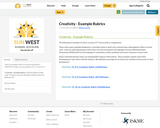
These are example rubrics for measuring growth in CREATIVITY. Rubrics are provided for K-5, 6-9 and 10-12.

I have been doing expert writing with the older students for a few years now as an independent English Language Arts project while I am working with the younger students. However, I have been disappointed with the variety and creativity in presentations. I give them a list of possible formats and they choose the topic they are interested in researching and how they want to present what they have learned. Only 1 or 2 have been brave enough to deviate from the traditional written report, or poster. My plan was to do a variety of creativity projects from the Destination Imagination series to foster creativity and get them in the right frame of mind before doing their projects. I insisted that they had to choose a format other than a written report, or poster
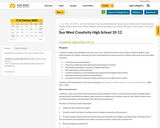
Sun West Creativity High School 10-12 Guidebook - please use the table of contents to navigate this guidebook. Also, we invite you to share resources you think would be suitable for this guidebook with any of the author's of this guidebook.
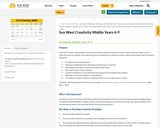
Sun West Creativity Middle Years 6-9 Guidebook - please use the table of contents to navigate this guidebook. Also, we invite you to share resources you think would be suitable for this guidebook with any of the author's of this guidebook.
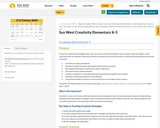
Guidebook for teaching the 21st Century Skill Creativity
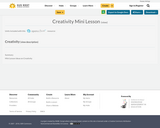
Mini Lesson Ideas on Creativity

Cree Code Talker reveals the role of Canadian Cree code talker Charles ‘Checker’ Tomkins during the Second World War. Digging deep into the US archives it depicts the true story of Charles’ involvement with the US Air Force and the development of the code talkers communication system, which was used to transmit crucial military communications, using the Cree language as a vital secret weapon in combat.

In this lesson, students will expand their knowledge and dive deeper into lesser-known Indigenous histories in Canada, particularly those of Second World War Cree Code Talkers. Students will then be asked to summarize and compare both histories.
What are Cree Code Talkers? What was their purpose?
During the Second World War, encryption and coded messages were deemed essential to winning the war. Utilizing Cree, the government relied on Indigenous men to use their language to aid the war effort; these men were known as Cree Code Talkers.
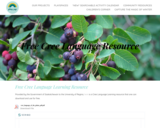
Provided by the Government of Saskatchewan to the University of Regina, this is a Cree Language Learning resource that one can download and use for free.
The comprehensive resource includes chapters on dialects, many grammatical topics, expressions, vocabulary and much more.
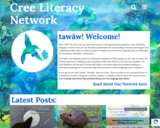
This amazing site is full of posts, favourite information, teachings, songs, maps and so much more - all related to preserving and learning the Cree language.

We’ve talked about deviance more broadly, but today we’re focusing on crime, specifically in the US. We’ll start with legal definitions of crime and use FBI data to get an idea of the amount and kinds of crime committed in the US. We’ll also use that date to paint a demographic picture of who gets arrested, and explain why that’s not necessarily a full look of who commits crime. We’ll also discuss society’s response to crime in the criminal justice system, and how that response has resulted in mass incarceration.

Law enforcement has relied on fingerprint analysis to identify suspects and solve crimes for more than 100 years. Investigators use fingerprints to link a perpetrator to a crime scene. Individual fingerprint identification records have also been used in sentencing, probation, and parole decisions. Officers often rely on chemical techniques, such as those above, to visualize the evidence. However, inadequate proficiency testing of investigators has led to inaccurate interpretations of the evidence. Recent wrongful convictions and scientific studies of forensic methods have increased scrutiny of the validity and reliability of several forms of forensic evidence, including fingerprints. A recent report prepared by the President’s Council of Advisors on Science and Technology (PCAST) makes strong recommendations for improving the scientific basis of forensic evidence used in the courtroom. For fingerprinting, the report emphasized the potential for automating fingerprint analysis, to potentially reduce bias in interpreting match results when fingerprints at a scene are smudged or otherwise unclear.

How It’s Done
Samples That May be Collected at a Crime Scene
A wide variety of physical evidence can be collected at a scene that is deemed valuable (“probative”) for collection and investigation:
-biological evidence (e.g., blood, body fluids, hair and other tissues)
-latent print evidence (e.g., fingerprints, palm prints, foot prints)
-footwear and tire track evidence
-trace evidence (e.g., fibers, soil, vegetation, glass fragments)
-digital evidence (e.g., cell phone records, Internet logs, email messages)
-tool and tool mark evidence
-drug evidence
-firearm evidence
Also included:
-Who Examines Crime Scenes
-How a Crime Scene Investigation is Conducted
-How and Where Tests on the Evidence are Conducted

Crime Scene features fictional crime cases in a unique combination of interactive fiction and gaming.
Each week, Yoknapatawpha County detectives post evidence from the current case.
You are invited to participate in the investigation by reviewing the presented evidence and offering your theories and questions to the detectives and other web sleuths.
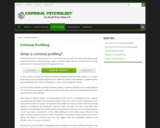
What is criminal profiling?
Criminal profiling is an important part of a criminal psychology. This part of an article will partially answer questions about what criminal profiling is, what it is used for, what is aim of it, in which cases it is mostly used, what are it’s types and what kind of approaches it has.
In short, Criminal profiling (also known as offender profiling and specific profile analysis) is to create a psychological and not only psychological portrait, determine location of the offenders by gathering their personal attributes from crime scene behavior in order to assist in detection of them.
Criminal profiling is typically used when offender’s identity is unknown and with serious criminal offences such as murder, sexual assault. Profilers also work on crime series, where is considered, that the crime is committed by the same offender.
Also included:
-The Process of Criminal Profiling
-Forensic Psychology
-Criminal Behavior
-Interviewing

Students will really warm up to this lesson about global warming as they study multimedia materials and use a variety of comprehension strategies.

Critical Thinking Cheat Sheet from Wabisabi Learning.
This great resource looks at the who, what, where, when, why and how of critical thinking.

These are example rubrics for measuring growth in CRITICAL THINKING. Rubrics are provided for K-5, 6-9 and 10-12.
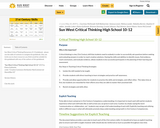
Sun West Critical Thinking 10-12 High School Guidebook - please use the table of contents to navigate the guidebook. Also, we invite you to share resources you think would be suitable for this guidebook with any of the authors of this guidebook.